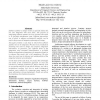Free Online Productivity Tools
i2Speak
i2Symbol
i2OCR
iTex2Img
iWeb2Print
iWeb2Shot
i2Type
iPdf2Split
iPdf2Merge
i2Bopomofo
i2Arabic
i2Style
i2Image
i2PDF
iLatex2Rtf
Sci2ools
108
Voted
ICSM
2003
IEEE
2003
IEEE
Software Systems Integration and Architectural Analysis - A Case Study
Software systems no longer evolve as separate entities but are also integrated with each other. The purpose of integrating software systems can be to increase user-value or to decrease maintenance costs. Different approaches, one of which is software architectural analysis, can be used in the process of integration planning and design. This paper presents a case study in which three software systems were to be integrated. We show how architectural reasoning was used to design and compare integration alternatives. In particular, four different levels of the integration were discussed (interoperation, a so-called Enterprise Application Integration, an integration based on a common data model, and a full integration). We also show how cost, time to delivery and maintainability of the integrated solution were estimated. On the basis of the case study, we analyze the advantages and limits of the architectural approach as such and conclude by outlining directions for future research: how to...
Architectural Analysis | Enterprise Application Integration | ICSM 2003 | Software Engineering | Software Systems |
Related Content
| Added | 04 Jul 2010 |
| Updated | 04 Jul 2010 |
| Type | Conference |
| Year | 2003 |
| Where | ICSM |
| Authors | Rikard Land, Ivica Crnkovic |
Comments (0)

